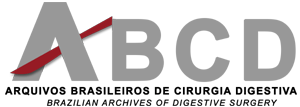Resumo em Português:
RESUMO RACIONAL: O tecido adiposo, músculos e ossos representam órgãos endócrinos, capazes de interferir no perfil metabólico e risco cardiovascular. Relacionar esses componentes será importante para estratégias de intervenção precoce, em obesos. OBJETIVOS: Avaliar a influência dos compartimentos da massa corporal, sobre o perfil metabólico e risco cardiovascular, no pré-operatório de cirurgia bariátrica. MÉTODOS: Estudo transversal, com pacientes admitidos para cirurgia bariátrica, em hospital universitário. A composição corporal foi avaliada pela absortometria radiológica de dupla energia e o risco cardiovascular pelo escore de risco de Framingham. Foram analisadas variáveis antropométricas, clínicas e de estilo de vida. Foi avaliado perfil lipídico (colesterol total, HDL-c, LDL-c, triglicerídeos), glicemia e vitamina D, utilizando a metodologia padrão. RESULTADOS: Foram analisados 60 pacientes, 86,7% apresentavam comorbidades, 33,3% risco cardiovascular moderado/elevado e 71,4% insuficiência/deficiência de vitamina D. Menor massa corporal magra associou-se à gravidade da obesidade. O índice de massa corpórea e a circunferência da cintura correlacionaram-se negativamente com a massa corporal magra (r=-0,52; p<0,01)/r=-0,36; p<0,01). A massa corporal magra correlacionou-se negativamente com a massa gorda (r=-0,26; p<0,05), gordura troncular (r=-0,29; p<0,05), glicemia de jejum (r=-0,26; p<0,05) e densidade mineral óssea (r=-0,26; p<0,05). Ao todo, 84,2% dos indivíduos com menos gordura troncular apresentaram tendência a baixo risco cardiovascular (p=0,05). Contudo, inatividade física (razão de prevalência ajustada 2,14; IC95% 1,19–5,54) e risco de dependência alcoólica foram as únicas variáveis independentemente associadas ao risco cardiovascular. CONCLUSÕES: Os pacientes obesos em pré-operatório de cirurgia bariátrica com menos gordura troncular, apresentaram tendência a baixo risco cadiovascular. Contudo, o risco cardiovascular também não foi associado aos demais componentes da massa corporal.
Resumo em Inglês:
ABSTRACT BACKGROUND: Fat, muscle, and bone are endocrine organs capable of affecting the metabolic profile and cardiovascular risk. Relating these components is important to the establishment of early intervention strategies for overweight patients. AIMS: This study aimed to evaluate the influence of body mass components on the metabolic profile and cardiovascular risk in the preoperative period of bariatric surgery. METHODS: A cross-sectional study was conducted with patients admitted for bariatric surgery at a university hospital in the city of Recife, Brazil, between 2018 and 2019. Body composition was determined using dual-energy x-ray absorptiometry. Cardiovascular risk was assessed using the Framingham risk score. Data were collected on anthropometric, clinical, and lifestyle characteristics. The lipid profile (total cholesterol, high-density lipoprotein cholesterol, low-density lipoprotein cholesterol, and triglycerides), blood glucose, and vitamin D were determined using the standard methods of the hospital laboratory. RESULTS: A total of 60 patients were analyzed, 86.7% of whom had comorbidities, 33.3% had moderate/high cardiovascular risk, and 71.4% had vitamin D insufficiency/deficiency. Lower lean body mass (adjusted PR 3.24; 95%CI 1.19–5.77) was independently associated with the severity of obesity. The body mass index and waist circumference were negatively correlated with lean body mass (r=-0.52; p<0.01)/r=-0.36; p<0.01). Lean body mass was negatively correlated with fat mass (r=-0.26; p<0.05), trunk fat (r=-0.29; p<0.05), fasting glucose (r=-0.26; p<0.05), and bone mineral density (r=-0.26; p<0.05). A total of 84.2% of individuals with less trunk fat tended to have low cardiovascular risk (p=0.05). However, physical inactivity (adjusted PR 2.14; 95%CI 1.19–5.54) and the risk of alcohol dependence (adjusted PR 2.41; 95%CI 1.76–4.15) were the only variables independently associated with cardiovascular risk. CONCLUSION: Obese patients in the preoperative period of bariatric surgery with less trunk fat tended to have low cardiovascular risk. However, the other components of body mass were also not associated with cardiovascular risk.
